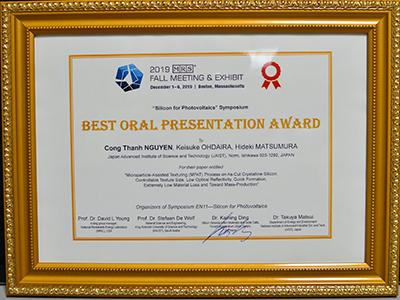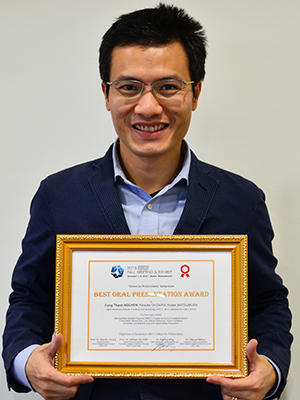Post-doctoral researcher Nguyen,Energy and Environment Area, received Best Oral Presentation Award in 2019MRS Fall Meeting
Post-doctoral researcher Nguyen Cong Thanh in Ohdaira Lab., Energy and Environment Area, received a Best Oral Presentation Award in 2019MATERIALS RESEARCH SOCIETY(MRS) Fall Meeting.
The MRS meeting showcases leading interdisciplinary research in both fundamental and applied areas presented by scientists from around the world.
The 2019 MRS Fall Meeting was held December 1 - December 6, 2019, in Boston, Massachusetts, the United States of America
■Date Awarded
December 5,2019
■Title
Microparticle-Assisted Texturing (MPAT) Process on As-Cut Crystalline Silicon:Controllable Texture Size, Low Optical Reflectivity, Quick Formation, Extremely Low Material Loss andToward Mass-Production
■Author
Cong Thanh NGUYEN, Keisuke OHDAIRA, Hideki MATSUMURA
■Abstract
We presented a novel technique to form random textures on as-cut crystalline silicon (c-Si) used for sunlight trapping in solar cells, so-called microparticle-assisted texturing (MPAT) process, in which glass microparticles were mixed with conventional alkaline-based texturing chemical solutions. As a result, the texture size, etching duration, solution consumption, and c-Si etched loss were reduced by almost one order of magnitude. Consequently, the texturing cost should be reduced by the same order. Especially optical reflectivity (R) is ~ 7%, almost world-record for the random textures. The MPAT process was applicable to c-Si wafers with thickness down to 50 µm for low material cost. The superiorities were attributed to that the glass microparticles with certain kinetic energy can sweep out reaction-generated hydrogen bubbles from the c-Si surface to speed up the texture formation. In addition, we developed a suitable wet chemical cleaning prior to surface passivation using catalytic chemical vapor deposition (Cat-CVD) silicon nitride (SiNx)/amorphous silicon (a-Si) stacked layers. A world-record low surface recombination velocity (SRV) ~0.38 cm/s was achieved. Toward mass-production using the MPAT process, we fabricated an MPAT machine for etching of multiple full-size wafers with a pitch of 5 mm to obtain uniform textures with a yield almost 100%. The standard deviation of R is < 0.1% over all the wafers in the same batch. Therefore, the MPAT process is realistic in the mass-production of the low-cost and high-performance thin c-Si-based solar cells.
■Comment
We are excited and honored to receive the award. We sincerely appreciate the attention that the materials research society (MRS) gives to our work. I appreciate my colleagues have done to help and encourage me in my professional growth, especially Prof. Matsumura and Prof. Ohdaira. I could not ask for more effective mentors who always encouraged me even when doing crazy ideas, like trying some materials bought from supermarkets, fabricating experimental tools, and very patient to wait for my very-long-time consideration before doing experiments, and so on. I deeply appreciate your trust in me!
I also would like to thank NEDO (New Energy and Industrial Technology Development Organization), Japan for their financial support.


January 10,2020
